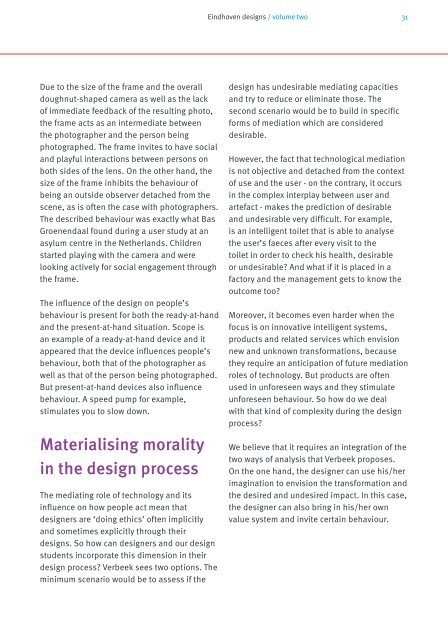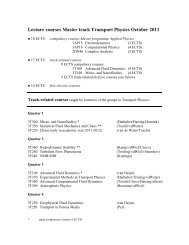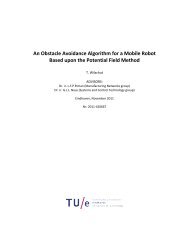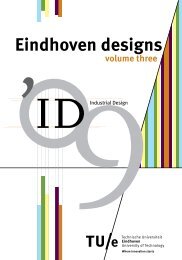Education guide 'Eindhoven designs' - Technische Universiteit ...
Education guide 'Eindhoven designs' - Technische Universiteit ...
Education guide 'Eindhoven designs' - Technische Universiteit ...
Create successful ePaper yourself
Turn your PDF publications into a flip-book with our unique Google optimized e-Paper software.
Eindhoven designs / volume two 31<br />
Due to the size of the frame and the overall<br />
doughnut-shaped camera as well as the lack<br />
of immediate feedback of the resulting photo,<br />
the frame acts as an intermediate between<br />
the photographer and the person being<br />
photographed. The frame invites to have social<br />
and playful interactions between persons on<br />
both sides of the lens. On the other hand, the<br />
size of the frame inhibits the behaviour of<br />
being an outside observer detached from the<br />
scene, as is often the case with photographers.<br />
The described behaviour was exactly what Bas<br />
Groenendaal found during a user study at an<br />
asylum centre in the Netherlands. Children<br />
started playing with the camera and were<br />
looking actively for social engagement through<br />
the frame.<br />
The influence of the design on people’s<br />
behaviour is present for both the ready-at-hand<br />
and the present-at-hand situation. Scope is<br />
an example of a ready-at-hand device and it<br />
appeared that the device influences people’s<br />
behaviour, both that of the photographer as<br />
well as that of the person being photographed.<br />
But present-at-hand devices also influence<br />
behaviour. A speed pump for example,<br />
stimulates you to slow down.<br />
Materialising morality<br />
in the design process<br />
The mediating role of technology and its<br />
influence on how people act mean that<br />
designers are ‘doing ethics’ often implicitly<br />
and sometimes explicitly through their<br />
designs. So how can designers and our design<br />
students incorporate this dimension in their<br />
design process? Verbeek sees two options. The<br />
minimum scenario would be to assess if the<br />
design has undesirable mediating capacities<br />
and try to reduce or eliminate those. The<br />
second scenario would be to build in specific<br />
forms of mediation which are considered<br />
desirable.<br />
However, the fact that technological mediation<br />
is not objective and detached from the context<br />
of use and the user - on the contrary, it occurs<br />
in the complex interplay between user and<br />
artefact - makes the prediction of desirable<br />
and undesirable very difficult. For example,<br />
is an intelligent toilet that is able to analyse<br />
the user’s faeces after every visit to the<br />
toilet in order to check his health, desirable<br />
or undesirable? And what if it is placed in a<br />
factory and the management gets to know the<br />
outcome too?<br />
Moreover, it becomes even harder when the<br />
focus is on innovative intelligent systems,<br />
products and related services which envision<br />
new and unknown transformations, because<br />
they require an anticipation of future mediation<br />
roles of technology. But products are often<br />
used in unforeseen ways and they stimulate<br />
unforeseen behaviour. So how do we deal<br />
with that kind of complexity during the design<br />
process?<br />
We believe that it requires an integration of the<br />
two ways of analysis that Verbeek proposes.<br />
On the one hand, the designer can use his/her<br />
imagination to envision the transformation and<br />
the desired and undesired impact. In this case,<br />
the designer can also bring in his/her own<br />
value system and invite certain behaviour.

















